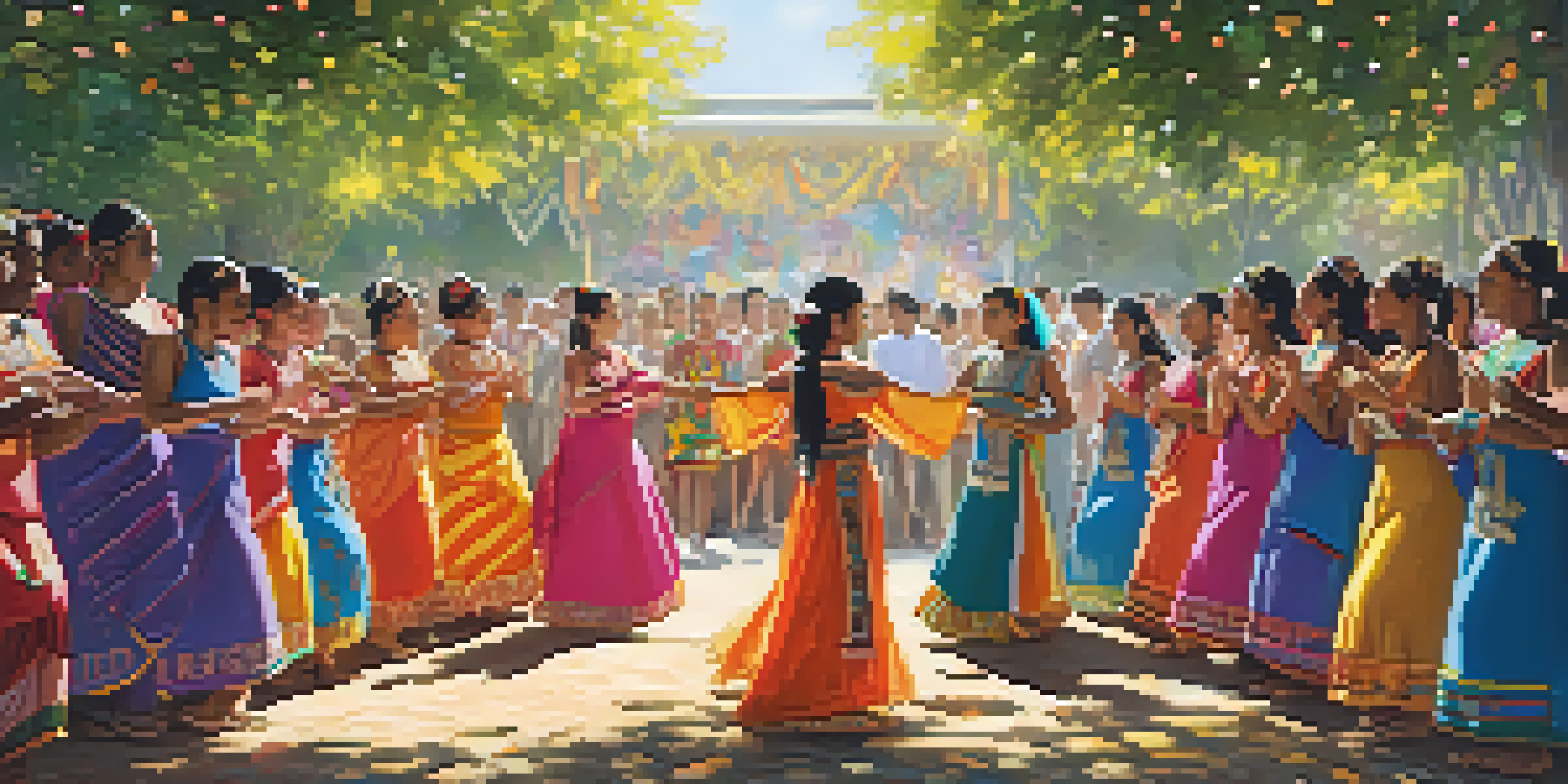The Influence of Art on Rites of Passage Globally

Understanding Rites of Passage and Their Importance
Rites of passage are significant ceremonies that mark life transitions, such as birth, adulthood, marriage, and death. They serve as a way for individuals to move from one stage of life to another, often accompanied by cultural practices and traditions. These rituals can vary widely across cultures, but they all share the common goal of acknowledging change and personal growth.
Art is the most beautiful of all lies; it is the most beautiful of truths.
The significance of these rites goes beyond mere tradition; they help individuals understand their place within society. They foster a sense of belonging and community, reinforcing social bonds and shared values. By participating in these ceremonies, individuals often gain insights into their identity and purpose, setting the stage for their next chapter.
Art plays a crucial role in these transitions, as it can encapsulate the emotions and narratives associated with each rite. From music and dance to visual arts, these forms become powerful tools for expressing the complexities of human experience during pivotal moments in life.
Art as a Means of Expression in Rites of Passage
Art serves as a vital means of expression in rites of passage, allowing participants to convey their emotions, hopes, and fears. For instance, during a coming-of-age ceremony, young people may perform traditional dances that symbolize their readiness for adulthood. These dances are often rich in cultural significance, showcasing the history and values of their community.

Moreover, visual arts like paintings and sculptures can also play a role in these ceremonies. They often depict pivotal moments in a person's journey or represent cultural symbols that resonate with the participants. This artistic representation can create a deeper connection to the ritual, enhancing the experience and helping individuals internalize their transformation.
Significance of Rites of Passage
Rites of passage are essential ceremonies that facilitate individual transitions and foster a sense of belonging within a community.
By integrating art into these rites, communities not only preserve their cultural heritage but also create a space for personal reflection. This fusion of art and ritual allows individuals to engage with their emotions and experiences, making the transition more meaningful and memorable.
Diverse Global Practices of Rites of Passage
Across the globe, different cultures have unique practices surrounding rites of passage. For example, the Maasai of Kenya have a distinct coming-of-age ceremony for young warriors, which involves elaborate rituals and artistic displays. These events are not only celebrations but also crucial in instilling values of bravery and responsibility.
Rites of passage are important cultural markers that help individuals navigate the complexities of life.
Similarly, in many Indigenous cultures, vision quests are rites of passage where individuals embark on a solitary journey into nature. During these quests, art becomes a medium for personal expression, whether through the creation of ceremonial objects or the recording of experiences through storytelling.
These diverse practices highlight how art is woven into the fabric of life transitions, allowing cultures to express their beliefs and values. Each ritual, no matter how varied, showcases the universal need for communities to honor growth and change through artistic expression.
The Role of Music in Rites of Passage
Music is a powerful form of art that often accompanies rites of passage, providing both a backdrop and a catalyst for emotional experiences. From the rhythmic beats of drums in African ceremonies to the melodic tunes of folk songs in Western weddings, music enhances the atmosphere of these significant moments. It helps to unify participants, creating a sense of shared experience and connection.
In many cultures, specific songs or chants are performed during these rituals, each with its own meaning and purpose. For instance, in Jewish tradition, the 'Hava Nagila' is often played during bar and bat mitzvahs, celebrating the coming of age with joyous music that encourages communal participation. This musical element not only marks the occasion but also reinforces cultural identity.
Art Enhances Personal Transformation
Art plays a crucial role in rites of passage, allowing individuals to express emotions and deepen their connection to significant life changes.
Furthermore, music can evoke powerful emotions, helping individuals process their feelings during these transitions. It can uplift spirits, offer solace during times of grief, and create lasting memories that individuals can carry with them throughout their lives.
The Impact of Visual Arts on Rites of Passage
Visual arts, such as painting, sculpture, and body art, play a significant role in various rites of passage around the world. For instance, in many Polynesian cultures, tattooing is a rite of passage that symbolizes strength, courage, and identity. The intricate designs are not just decorative; they tell a story about the individual's life journey and cultural heritage.
In addition to body art, ceremonial masks and costumes are often used in rites of passage to represent different roles within the community. For example, in some African cultures, masks worn during initiation ceremonies embody ancestral spirits, connecting the participants to their past and cultural roots. This artistic expression adds depth to the ritual, enhancing its significance.
The creation and presentation of visual art during these ceremonies also encourage communal engagement. Family and community members may contribute to the artistic process, fostering a sense of unity and shared purpose. This collaborative effort not only enriches the experience but also reinforces cultural continuity.
The Influence of Performance Art in Rites of Passage
Performance art, including dance and theater, is another vital component of many rites of passage. These forms of expression allow individuals to embody their experiences and emotions, often conveying complex narratives in a captivating way. For example, traditional dances performed during weddings or graduations serve to celebrate the milestones in a vibrant and engaging manner.
In some cultures, storytelling through performance is integral to rites of passage. Elders may recount tales of bravery or wisdom, passing down vital cultural lessons while participants engage in the enactment of these stories. This dynamic interaction creates a rich tapestry of learning and sharing that deepens the understanding of the community's values.
Modern Adaptations of Traditions
Contemporary rites of passage integrate new artistic expressions and digital elements while maintaining their core purpose of honoring growth and community bonds.
Moreover, the physicality of performance art can be transformative for participants. Engaging in dance or theatrical expressions during these rites can help individuals embrace their new roles, fostering confidence and a sense of empowerment as they navigate their transitions.
The Evolution of Rites of Passage in Modern Society
As societies evolve, so do their rites of passage, often integrating contemporary art forms and ideas. Modern ceremonies may blend traditional practices with new artistic expressions, reflecting the changing values and identities of individuals today. For instance, while a wedding may still include age-old customs, couples often infuse personal touches, such as unique music playlists or custom vows, to make the event their own.
Digital art and multimedia have also found their way into rites of passage. Virtual ceremonies and online celebrations have become more common, especially in recent years, allowing people to connect and share experiences from afar. This evolution showcases the adaptability of art and tradition in responding to the needs of modern life.

Yet, amidst these changes, the core purpose of rites of passage remains intact: to honor growth, celebrate transitions, and strengthen community bonds. Art continues to play a crucial role in these ceremonies, whether through traditional means or innovative approaches, ensuring that the spirit of these rituals lives on.